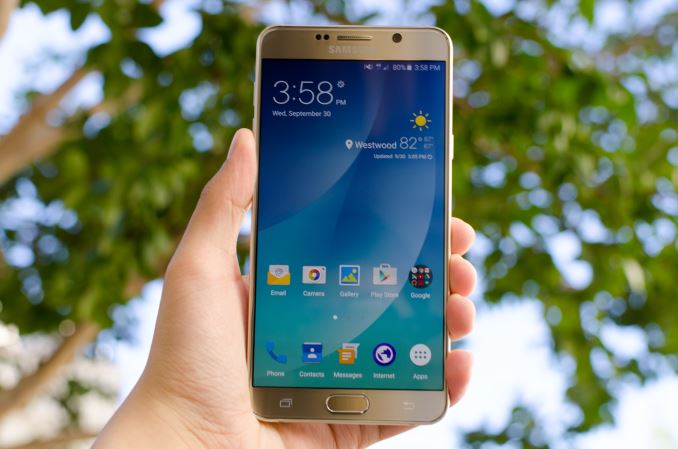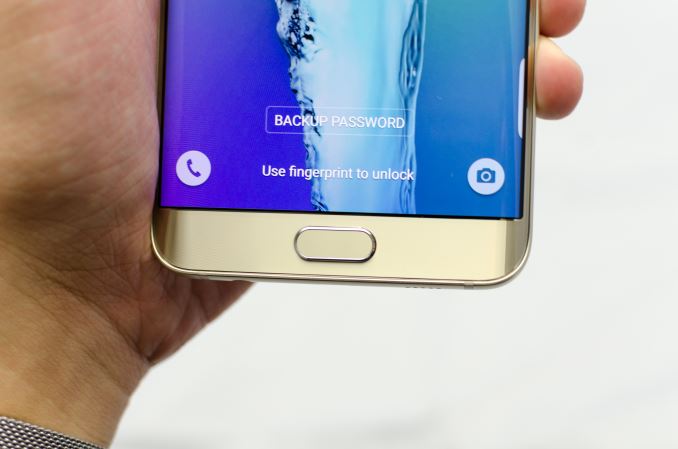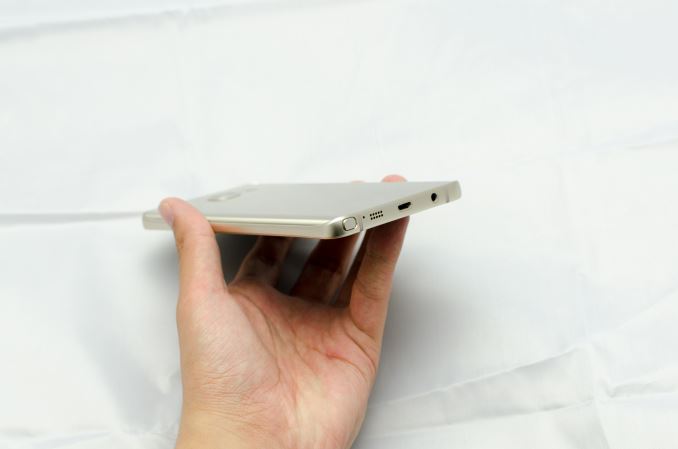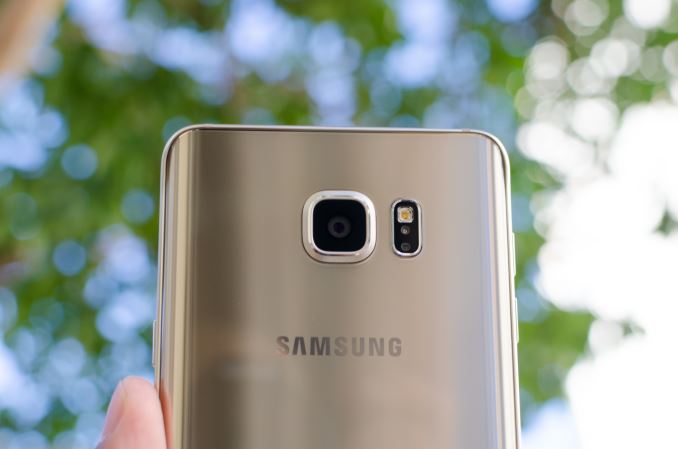The Samsung Galaxy Note5 and Galaxy S6 edge+ Review
by Joshua Ho on October 2, 2015 8:00 AM ESTFinal Words
The Galaxy Note5 is a bit of a break in form for Samsung, but in some ways it represents a return to form. To understand what this means, we can look at the various aspects that make up the Galaxy Note5 in contrast to the Galaxy S6. One of the easier places to start is the design, which shares a great deal in common with the Galaxy S6. We see a similar reflective coating under the glass, a glass back cover, an aluminum midframe, and the usual home button and thin bezels. The fingerprint scanner in the home button works about as well as you would expect and is comparable to the Galaxy S6.
The next aspect of the phone worth looking at is battery life. Here, we see that the Note5 gets a healthy bump in battery life relative to the Galaxy S6. Relative to the Note 4, battery life is basically comparable and not all that different. It seems that Samsung’s theme this year is maintaining battery life by reducing battery size and improving power efficiency. Those looking for a removable battery might be disappointed, but if you never swapped the battery in a phone like the Galaxy Note 4 there’s nothing to really worry about here. Samsung has also retained fast charging capabilities, so it isn’t nearly as important to swap batteries.
The display of the Galaxy Note5 continues to be incredible. Out of all the Android OEMs right now, Samsung is the best at display. I’m still of the opinion that the best LCDs are comparable with Samsung’s latest AMOLED panels, but within the next year or two I’m fairly confident that they won’t have any competition here. However, given the lack of second source suppliers it seems unlikely that OEMs will move en masse to OLED as strongly relying on a single supplier for any critical part of a product could easily be a disastrous mistake. The Galaxy S6 edge+ has a similar level of display quality, but the edges of the display are clearly distorted to the eye due to the subpixel arrangement used.
The SoC used continues to be the best SoC you can get in any mobile device running Android. This is likely to change next year, but given the data it’s incontrovertible that the Exynos 7420 is the fastest and most efficient SoC available in an Android device. These two factors strongly affect user experience in workloads like web browsing, updating and installing apps, and gaming. If you do any of those three things, SoC performance has a strong influence upon overall user experience for you. NAND quality isn’t quite at the same level as the Galaxy S6, but it’s more than sufficient and is unlikely to be a problem for the duration of a two year contract.
Overall, the software experience is actually quite acceptable. TouchWiz has gotten a lot better in the past generation, and any time I pick up a Galaxy S3 or Galaxy S4 I’m immediately reminded of this. However, as mentioned in the Galaxy S6 review I don’t think it’s necessarily perfect. The smoothness of the UI isn’t as amazing as some of the phones I’ve used in the past, and there are sometimes odd choices in application design like icon design. Using a Material Design theme from the theme store goes a long way to dealing with this problem, but that’s no excuse for the default theme. The Note features are useful and the single biggest reason to buy the Galaxy Note5 over another phablet, but the edge features are decidedly impractical and generally not very useful. I still think it's possible to make a better skin than TouchWiz, but I can live with TouchWiz on a primary phone.
In the camera department, on the surface nothing has changed relative to the Galaxy S6. Even if Samsung didn’t do anything for the Galaxy Note5’s camera relative to the Galaxy S6, it would still be one of the best Android cameras you can get today. However, Samsung has included a number of new features like RAW capture and improved manual mode controls. In addition, they’ve dramatically improved low light photo processing to the point that I’m confident in saying that the Galaxy Note5 beats the LG G4 and iPhone 6 Plus, but in video performance the iPhone 6 Plus is still slightly better. The Galaxy Note5 is either as good as or better than the iPhone 6 Plus for overall camera quality depending upon how strongly you want to weight video recording.
Outside of these main areas of focus, overall I like the the Galaxy Note5. In chosing to mimic the Galaxy S6 so closely it's not a bold design for Samsung and you won't find much in the way of new features, but instead what you get is in many ways a big Galaxy S6. Often because of that it's not a perfect phone - Samsung could still afford to work on polish, particularly in regards to issues like inserting the stylus backwards or RAW files that aren’t deleted - however it also does a lot well like the 5.7" SAMOLED display, the camera, and the Exynos 7420 SoC.
If you’re looking for the best Android phablet on the market today the Galaxy Note5 or Galaxy S6 edge+ is likely to be your best bet. They may not be a big jump up from the Galaxy S6, but they're still the best Android phablets you can get today. In that sense, Samsung is departing from the sort of strategy that we saw with the Galaxy Note 3 and 4 in the form of a new SoC and other improvements that came with the Note line, but like the Galaxy Note 1 and 2 these are phablet variants of their Galaxy S cousin.















225 Comments
View All Comments
thedons1983 - Sunday, October 18, 2015 - link
Apple genius = regular retard. Those morons don't have a clue. I know more about iOS, than those idiots. Customer service does not equal customer satisfaction. Especially when the idevice in question breaks every few minutes.hrrmph - Sunday, October 4, 2015 - link
Nice review that hits most of the major points, but I would like to see a few more things returned to AT's reviews:- Audio performance (for many people, a phone is their primary audio source, so quality counts);
- Battery configuration (not to push the discussion one way or the other, just remind us whether it does or doesn't have a removable battery.);
- More on storage (considering AT's roots as a PC website, and smartphones' inexorable drive to eventually replace PCs, a wider discussion of storage is needed. Especially with phone cameras recording 4K and everyone's storage needs going up in formation, it is important to discuss how to store things on the device and how to offload them from the device. This issue is dogging Apple, Google, and Samsung, all of whom have now eschewed internal removable storage, without stating when they will develop a replacement, if ever.).
----------------
I would also like to see something added to AT's phone reviews:
- How to control audio playback without looking at the phone (particularly Play, Skip Forward to Next Song, and Skip Back to Previous Song, and Mute. Blackberry nailed most of this with their very helpful physical button configuration, and thus when driving in a car and playing music, I cannot be without a Blackberry. What are Apple, Google, Samsung and the others doing for audio control while driving... without having to buy a new car, that is. Is voice control the only way, and if so does it work well.)
SydneyBlue120d - Sunday, October 4, 2015 - link
Any info about the HEVC encoding? We know the SOC support it, however there is no way to use it, I think this relate to the HEVC licensing knightmare, do You think we will ever be able to use it? Maybe using some third parts app? Thanks a lot.kogaharukka - Sunday, October 4, 2015 - link
For Nand performance, please check it with Androbench v.4.0.The numbers from Androbench v.3.6 cannot show real Nand performance.
SnowleopardPC - Sunday, October 4, 2015 - link
My biggest issues with these phones are that Samsung surveyed Iphone users about what features they wanted in their next phone and of course the Isheep said nothing about Micro SD Card slots and changeable batteries.I went with Samsung because I want my 10,000 MAH extended battery and 200gb MicroSDXC card from Sandisk.
Now all Samsung makes is a cheap IPhone that runs anroid.
And the 128gb version was an after though and "might" be released in the next 2 months, and it still will be missing a micro SDXC card slot and have a low powered worthless battery......
thedons1983 - Sunday, October 18, 2015 - link
You are an idiot. Pure and simple. What a loser. Benchmarks are for idiots.coolhardware - Sunday, October 4, 2015 - link
As per the Kuzi's earlier comment:+the S6/Edge/Note 5 resolution of 2560x1140 = 3,686,400 pixels
+iPhone 6S Plus is 1920x1080 = 2,073,600 pixels.
A fewquestions: #1 how do these screens look next to each? (is there a noticeable quality difference)
#2 how much of a battery/performance penalty is there for Samsung? (are they competitive despite handling way more pixels, or do they suffer for it)
#3 how bright do the Samsung's get on "auto" b/c my S6 is visible in any sunlight conditions when in that mode, are the latest iPhone's also able to be viewed easily in full sun?
Lastly, why do AMOLED displays have difficulty with the "painted on" effect vs. LCDs? I notice that my wife's Moto X Pure's LCD looks crisper and more "painted on" than my S6.
PS thanks for the great review as always!
PSS For reference on the first questions, here are iPhone pixel densities: http://pixensity.com/search/?search=iphone
and Samsung Galaxy pixel densities: http://pixensity.com/search/?search=samsung%20gala...
Kuzi - Monday, October 5, 2015 - link
Thanks for the site showing the resolution and PPI for devices.To answer #2, Samsung have been improving/reducing the power draw of their AMOLED panels with each generation. So even while pushing such high resolutions the penalty is minimal, especially when compared to LCD technology.
For #3, you can check below and "Expand" the results to show more phones for the Sunlight Visibility test:
http://www.gsmarena.com/apple_iphone_6s-review-131...
ciderrules - Monday, October 5, 2015 - link
The power consumption for the higher resolution isn't just the display and technology. It's the GPU power required to drive that display. It takes more processing power to drive more pixels. Especially if you want day-to-day activities to be smooth (like scrolling).Kuzi - Tuesday, October 6, 2015 - link
The Galaxy S6 is getting 73 hours battery endurance rating:http://www.gsmarena.com/samsung_galaxy_s6-review-1...
iPhone S6 is getting 62 hours:
http://www.gsmarena.com/apple_iphone_6s-review-131...
So even though the Galaxy S6 is pushing 3.6 times more pixels compared to iPhone 6S it doesn't seem like the battery perfomance is suffering.
And the GPU doesn't run at high frequencies when web browsing or playing videos. Although for 3D games the battery will get drained faster with higher res screens for sure.